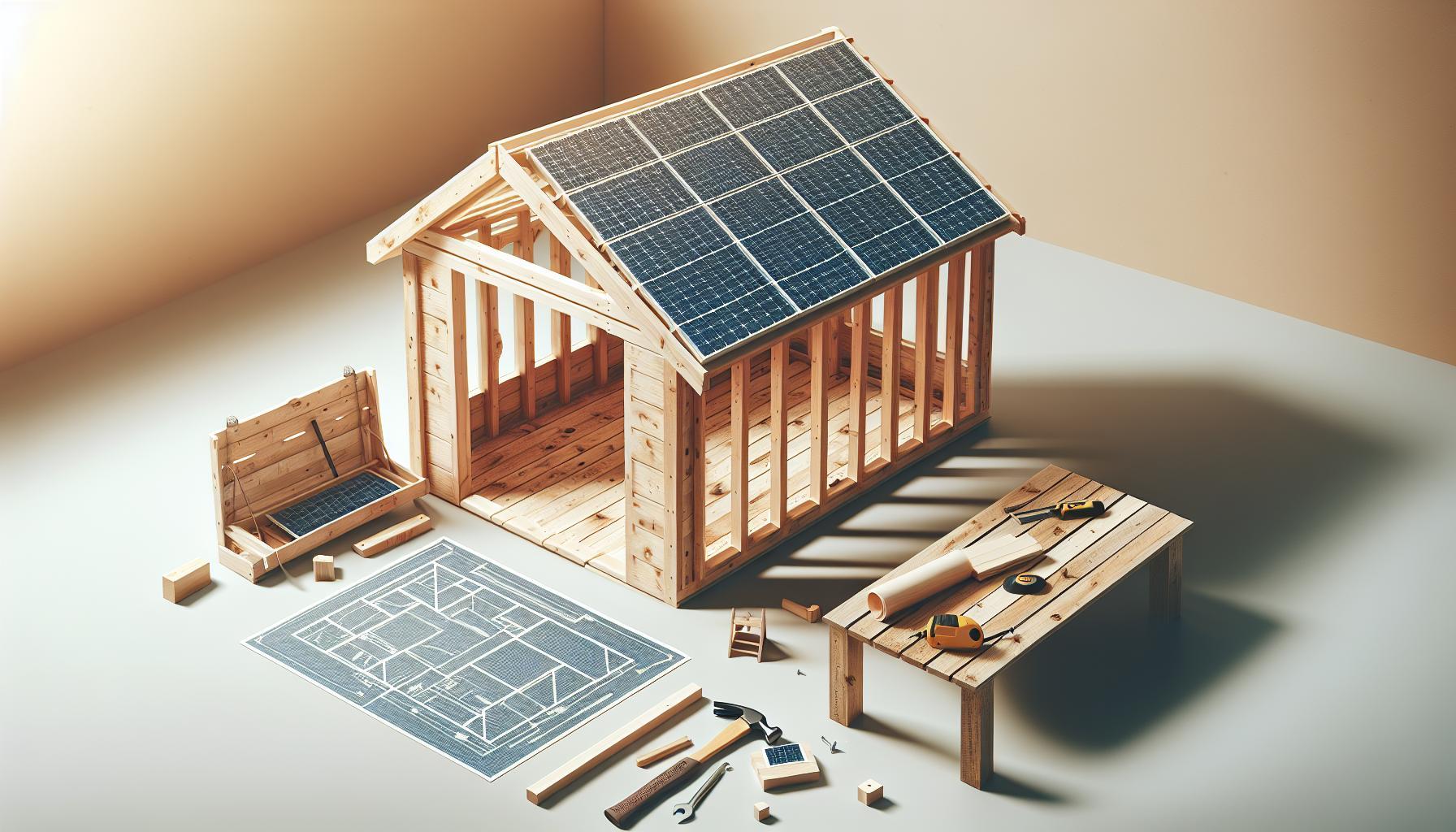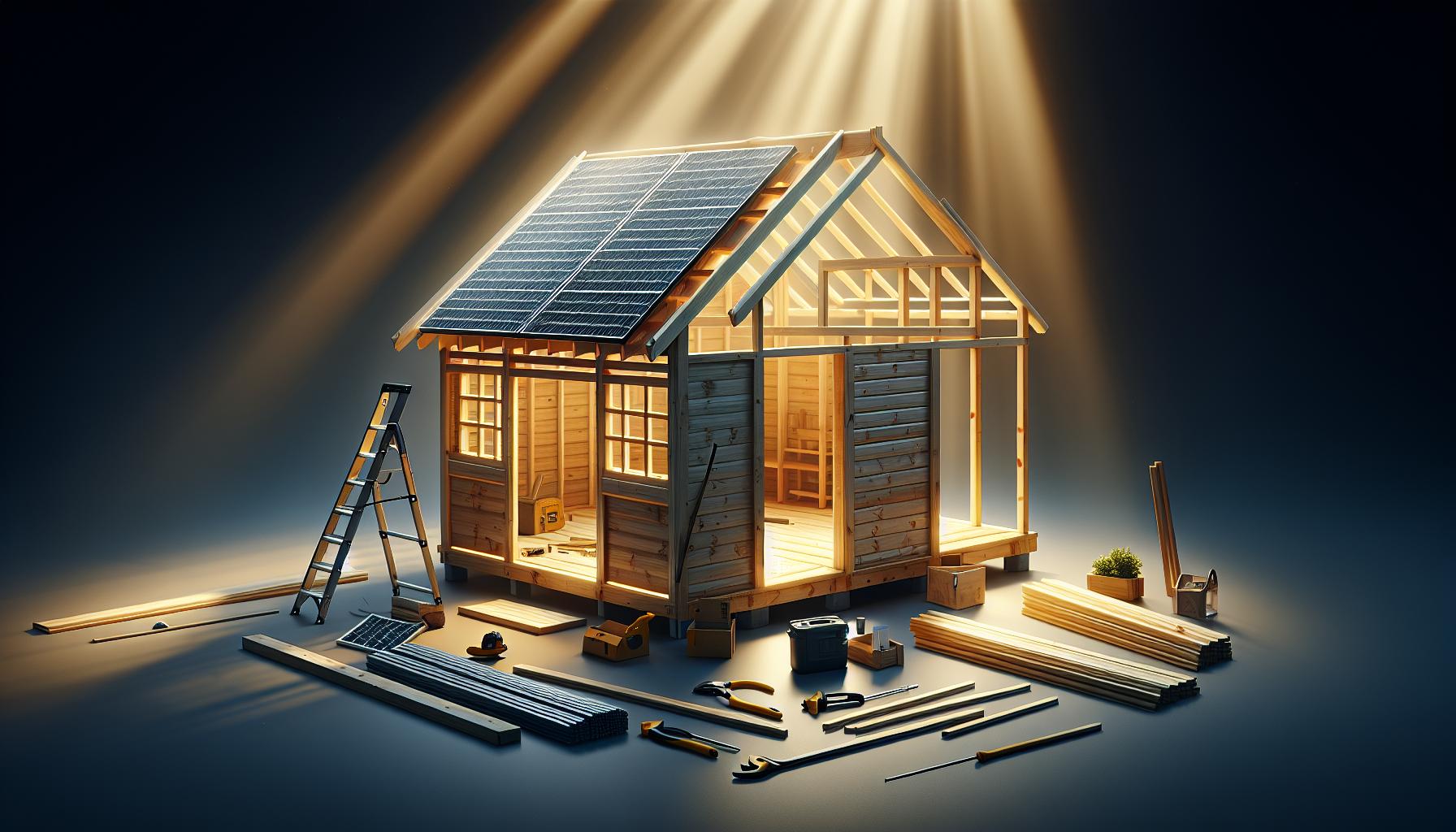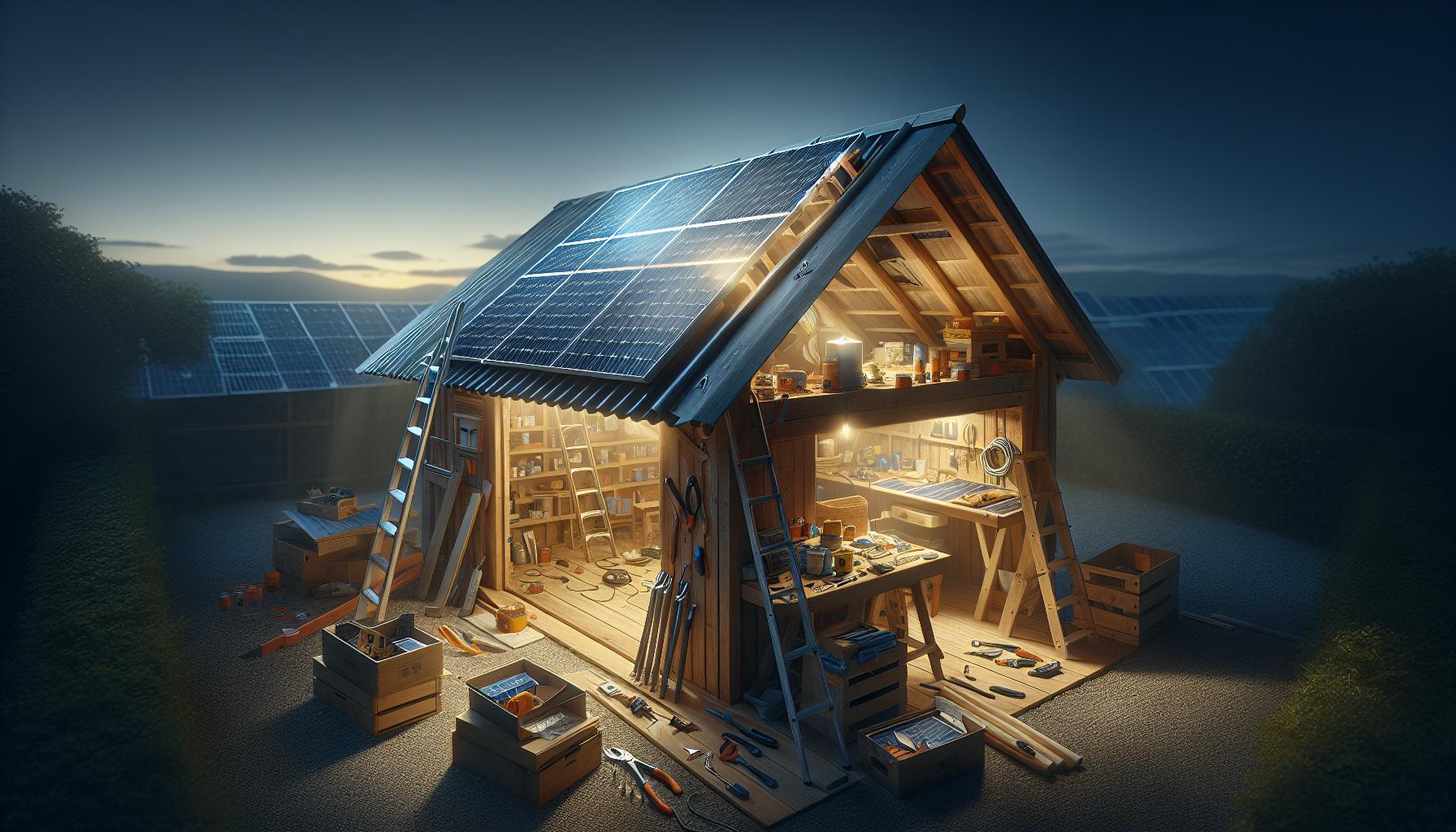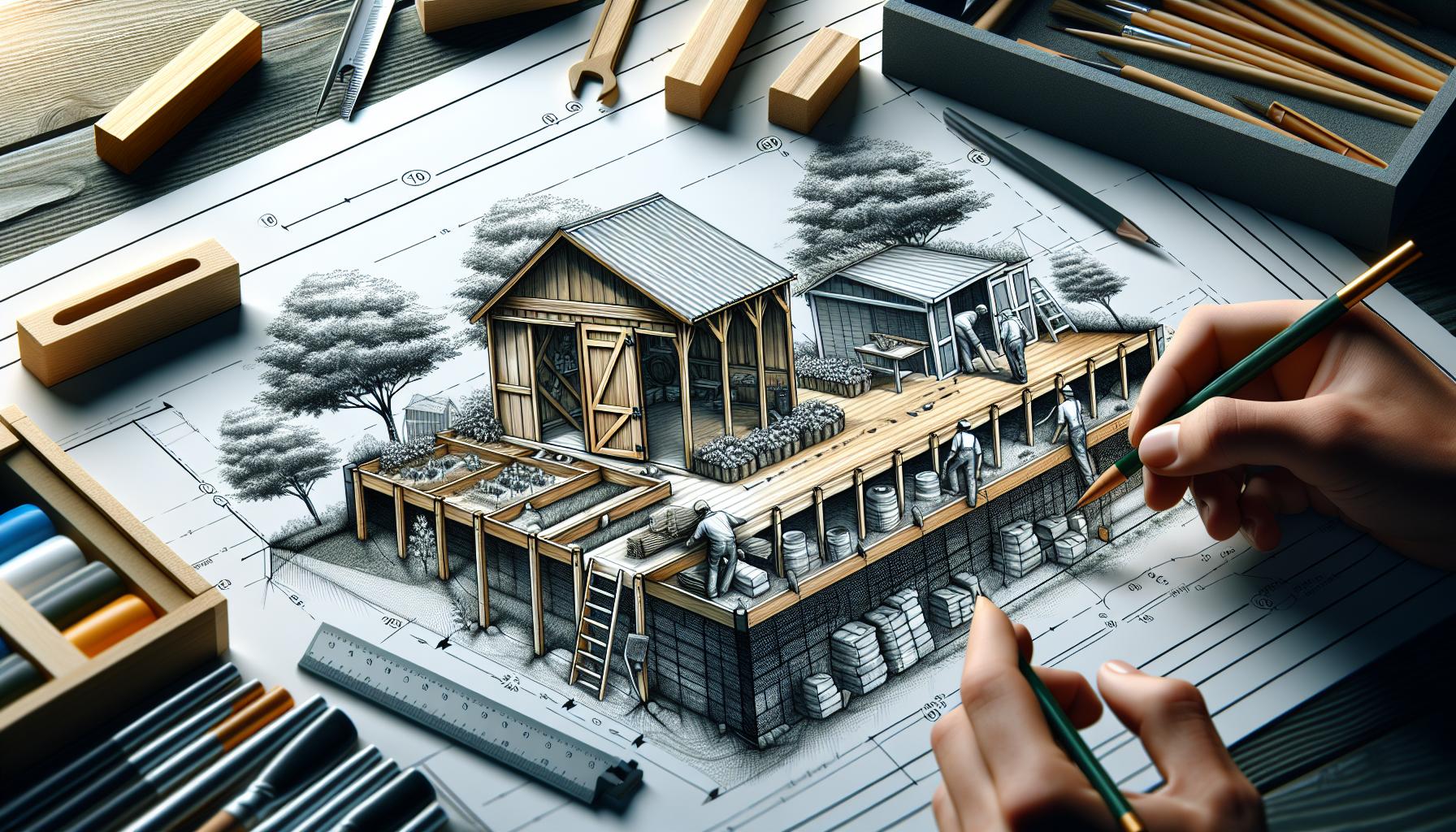are you tired of skyrocketing energy bills and seeking a lasting solution for your workspace? Building a solar-powered shed not only reduces costs but also promotes eco-friendliness. This guide will walk you through the steps to create your own sunny sanctuary, leveraging free energy while enhancing your productivity.Let’s transform that shed into a green powerhouse!
Understanding the Benefits of a Solar Shed for Your Workspace
The rise in renewable energy solutions has made it easier then ever to integrate sustainability into everyday life, and a solar shed offers an innovative way to embrace green energy in your workspace. Imagine generating your own electricity, minimizing your carbon footprint, and enjoying lower utility bills—all while having a well-organized space for your tools or equipment. In essence, a solar shed isn’t just an addition to your property; it’s an investment in a cleaner, more efficient future.
Cost Effectiveness
One of the most compelling reasons to consider a solar shed is its ability to substantially reduce energy costs. By harnessing the power of the sun, you can generate electricity that offsets your reliance on conventional power sources. This self-sufficiency can lead to ample savings on your electricity bills over time. Here are some key financial benefits to consider:
- Zero Energy Bills: With an adequately designed solar shed, you could eliminate your energy expenses, providing extra budget for other projects.
- Tax Incentives: Many regions offer tax credits, rebates, or other incentives for solar installations, making your initial investment more affordable.
- Increased Property Value: Properties equipped with renewable energy systems often see an increase in market value, making this an excellent long-term investment.
Sustainability and Environmental Impact
Constructing a solar shed aligns your workspace with sustainable practices, empowering you to play an active role in environmental stewardship. Solar energy is clean and renewable, reducing the reliance on fossil fuels and minimizing greenhouse gas emissions. By adopting this technology, you contribute positively to the environment while also setting a powerful example for others in your community.
Versatility and Functionality
A solar shed can serve multiple purposes, making it a highly functional addition to your property. Whether you need a space for gardening tools, a workshop, or a creative studio, incorporating solar panels allows you to design a workspace tailored to your unique needs. Additionally, with proper planning, the shed can be equipped with battery storage systems to ensure your energy supply is available long after the sun goes down.
| Feature | Benefit |
|---|---|
| Energy Generation | Produce your own electricity, reducing costs. |
| Storage Options | Versatile usage for tools, equipment, or creative spaces. |
| Environmental Impact | Lower your carbon footprint through renewable energy. |
| Increased Property Value | Enhances your home’s marketability and investment potential. |
a solar shed not only provides practical benefits but also represents a notable step forward in personal accountability toward energy consumption. As you explore how to build a solar shed, consider the long-term advantages of this unique structure, allowing you to transform your workspace into a model of efficiency and obligation.
Essential Materials and Tools Needed for Your Solar Shed Build
Building a solar shed is not just about enhancing your workspace; it’s also a step towards sustainability and energy independence.To ensure your project runs smoothly, a proper understanding of the necessary materials and tools can save you time and frustration. Here is a thorough overview to get you ready for your build.
Essential Materials
To create a functional and efficient solar shed, you’ll need a range of materials, each serving a specific purpose. Here’s a list of essential items you will require:
- Solar Panels: The heart of the energy system, choose panels with sufficient wattage to meet your needs.
- Battery Storage: Deep-cycle batteries to store the energy generated, allowing for off-peak usage.
- Charge Controller: This device regulates voltage and current coming from the solar panels to the batteries.
- inverter: Converts DC power from the batteries into AC power for use in your shed.
- Wiring and Connectors: Essential for connecting all components; ensure they are rated for outdoors.
- Mounting Hardware: Depending on your roof type, you may need brackets, screws, and other fasteners to secure the solar panels.
- Insulation Materials: To maximize energy efficiency, consider suitable insulation for your shed walls and roof.
- Building Materials: Lumber, plywood, and siding for the shed structure itself.
Key Tools
The right tools will significantly impact the ease and quality of your construction. Keep the following tools on hand for an efficient build process:
- Power Drill: Essential for making holes and fastening materials together.
- saws (Circular or Power Saw): Needed for cutting wood and other materials to size.
- wire Strippers: To prepare and connect wiring safely.
- Multimeter: Necessary for checking voltage and ensuring your electrical system operates correctly.
- Level: To ensure your solar panels are installed at the correct angle.
- Safety Gear: Don’t forget gloves, goggles, and safety boots to protect yourself during the build.
Budgeting Your Build
Understanding the potential costs of the materials and tools needed for your solar shed project ensures you stay within budget. Below is a simple portrayal of the average price range for some key components:
| Item | Average Cost |
|---|---|
| Solar Panels (per watt) | 0.50 – 1.00 USD |
| Deep-cycle Battery | 100 – 300 USD |
| Charge Controller | 30 – 200 USD |
| Inverter | 100 – 300 USD |
| Wiring & Connectors | 50 – 150 USD |
| Building Materials | Variable,500 – 2000 USD |
By gathering the right materials and tools,you lay a solid foundation for a prosperous solar shed build. This readiness not only enhances your workspace but also promotes energy efficiency and sustainability, making it a rewarding endeavor. With a clear list and an understanding of what you’ll need, you’re one step closer to harnessing free energy for your workspace.
Step-by-Step Guide to designing Your Solar Shed
Imagine transforming your workspace into a self-sufficient energy hub while minimizing your carbon footprint—this is the beauty of designing a solar shed. By harnessing the sun’s energy, you not only save on electricity costs but also contribute to a more sustainable future. This guide will walk you through each crucial step, ensuring your solar shed is not just a dream, but a reality.
Determine Your Shed’s Purpose
Before diving into the specifics of solar panel installation and energy calculations, it’s essential to clarify what you’ll be using your solar shed for. Consider the following factors:
- Functionality: Will it be a workshop, storage space, or an office?
- Equipment Needs: List all tools or devices you plan to use that require power.
- Size: How much space do you need for your activities and equipment?
Once you identify its primary purpose, you can determine the necessary power requirements and the scale of your solar system.
Evaluate Solar Energy Needs
next, assess how much energy your shed will require. This involves estimating the wattage of all equipment you intend to run. An effective method to calculate your needs is to aggregate the wattage of each device and multiply it by the number of hours you plan to use them each day.
To assist in this evaluation, you can use the table below to calculate your energy consumption:
| Device | Wattage (W) | Hours Used per Day | Daily Energy Consumption (Wh) |
|---|---|---|---|
| Power Tool | 500 | 2 | 1000 |
| LED light | 10 | 5 | 50 |
| Computer | 300 | 4 | 1200 |
| Refrigerator | 150 | 24 | 3600 |
| Total | 5850 Wh |
This total watt-hour calculation gives you a clearer picture of how much energy you’ll need to generate with your solar panels.
Select the Right Solar Equipment
With your energy needs assessed, it’s time to select the equipment that will power your shed. This includes solar panels, an inverter, batteries, and a charge controller. Here’s how to go about it:
- Solar Panels: Research panels with suitable wattage ratings. You’ll want to balance efficiency with your budget.
- Inverter: Choose an inverter that can handle your total wattage output. Ensure it converts DC to AC power effectively for your devices.
- Batteries: Look for batteries that can store enough energy for your usage patterns, or opt for a system that connects directly to the grid.
- Charge Controller: This will prevent overcharging and extend the life of your batteries if using a battery system.
By considering these aspects, you can ensure a reliable and efficient solar power setup tailored to your needs. Follow these steps carefully,and your solar shed will soon be harnessing free energy,enhancing your workspace with both functionality and sustainability.
Installing Solar Panels: Key Considerations and Techniques
Installing solar panels can transform not just the energy efficiency of your workspace, but also the way you perceive energy consumption altogether. When planning to build a solar shed, understanding the various factors involved in solar panel installation is crucial for optimizing your use of renewable energy. The right techniques and considerations can maximize your investment, making your workspace not only environmentally amiable but also cost-effective over time.
Site assessment
Before diving into the installation process,it’s essential to conduct a site assessment to determine the optimal placement of your solar panels. A few points to consider include:
- Sun Exposure: Ensure the site receives ample sunlight throughout the day,particularly during peak hours.
- Obstructions: Identify any trees, buildings, or other structures that may cast shadows on your solar panels.
- Roof Angle and Orientation: For rooftop installations, a south-facing slope at a 30-degree angle is generally recommended for maximum efficiency.
Gathering data on solar irradiance in your area can significantly assist in predicting energy output and ensuring that your investment pays off. Websites like the National Renewable Energy Laboratory (NREL) provide tools to evaluate solar potential based on geographical data.
Choosing the Right Equipment
Once you’ve assessed your location, selecting the appropriate solar panels and inverters is vital. With various types available, consider factors such as efficiency, cost, and warranty. Here’s a quick breakdown of popular solar panel types:
| Type | Efficiency | Cost | Durability |
|---|---|---|---|
| Monocrystalline | 15-22% | $$$ | 25+ years |
| Polycrystalline | 13-16% | $$ | 20-25 years |
| Thin-film | 10-12% | $ | 10-20 years |
Make sure to also consider grid-tied versus off-grid systems depending on your goal, whether it’s to connect to the existing grid or power your shed independently.
Installation Techniques
The installation of solar panels involves technical skills and adherence to safety protocols. Here are some techniques to keep in mind:
- Secure Mounting: Properly secure the solar panels to the mounting structures, whether on a roof or ground setup, to withstand wind and weather.
- Wiring: Use quality wiring that can handle the amperage generated, and follow best practices for making safe and lasting connections.
- Monitoring System: Implement a monitoring system to track energy production,ensuring your solar shed is functioning at optimal levels.
By meticulously planning your installation approach and being aware of essential techniques, you can ensure that your solar shed—conceptualized through the guide on how to build a solar shed and harness free energy—efficiently contributes to your energy needs for years to come.
Wiring Your Shed for Power: Simplified Electrical Basics
Wiring a shed for power not only enhances its functionality but also transforms it into a versatile workspace that can accommodate various needs, from simple storage to a fully equipped hobby shop. Understanding the electrical basics is essential for anyone looking to embark on the journey of connecting their shed to a power supply. Proper planning can prevent future headaches and potential safety hazards, allowing you to enjoy all the benefits that come from effectively harnessing energy—especially if you’re considering integrating solar power into your design.
To begin with, it’s crucial to map out how you plan to power your shed. Outlining the locations for outlets, switches, and light fixtures will guide your wiring process. Utilizing a main breaker panel specifically for the shed ensures you can control power distribution effectively. Here are key components you should consider:
- Circuit Breaker Panel: Essential for safety, it allows you to manage electricity more effectively.
- GFCI Outlets: Critically important for outdoor installations to protect against electrical shocks.
- Electrical Boxes: Use these to safely house your outlets and switches.
- Conduit and Wiring: Choose the right type for the environment, ensuring durability and protection against the elements.
When considering how to build a solar shed, integrating solar panels into your wiring plan can provide a sustainable energy source. Including components such as charge controllers, inverters, and batteries means your shed can become self-sufficient. As you wire your shed, make sure to keep safety standards in mind by utilizing materials suited for outdoor exposure and by consulting local building codes.Lastly, it’s advisable to seek guidance or assistance from a licensed electrician, especially if you’re not familiar with electrical work. Aiming for quality installation not only enhances the longevity of your wiring but also ensures that your solar-powered shed functions reliably,allowing you to harness free energy for your workspace while enjoying peace of mind.
Common Challenges in Solar Shed Construction and How to Overcome Them
When embarking on the journey of constructing a solar shed, you might find yourself navigating a maze of challenges. From maximizing available sunlight to ensuring durability and efficiency, these obstacles can seem daunting. However, understanding these common pitfalls and employing strategic solutions can transform your solar shed into a powerhouse of sustainable energy and functionality.
Site Selection and Sunlight Exposure
One of the foremost challenges in constructing a solar shed is selecting an optimal site. Trees, nearby buildings, and even the seasonal shift of the sun can obstruct solar panels, leading to decreased energy efficiency. To combat this, conduct a thorough site assessment prior to construction. Ideally, place your shed in an area that receives unobstructed sunlight for most of the day.
- Use a solar pathfinder tool or an app to analyze sunlight exposure.
- Consider seasonal changes, aiming for east-facing panels for morning sun and west-facing for afternoon light.
- Clear away any obstructions like branches that may shade your solar setup during peak sunlight hours.
Structural Integrity and Weather resistance
Another significant hurdle is ensuring that your solar shed can withstand various weather conditions while supporting solar panel installations. This involves choosing the right building materials and designs. Look for materials that are not only sturdy but also weather-resistant.
| Material | Benefits | Drawbacks |
|---|---|---|
| wood | Natural aesthetic, good insulator | Susceptible to rot, requires maintenance |
| Metal | Durable, low maintenance | Can heat up, less insulation |
| Composite | Weather resistant, low maintenance | costlier than wood |
Prioritize the shed’s design by ensuring the roof can support the weight of the solar panels while allowing for proper drainage. For installation, consider incorporating reinforced roofing or installing panels at an angle to maximize exposure.
Electrical Wiring and energy Storage
Integrating a solar power system brings about another layer of complexity—electrical wiring and energy storage solutions. Poorly set up wiring can lead to energy loss or safety hazards. To prevent this, meticulously plan your electrical layout and consider hiring a professional for the installation.
- Choose a charge controller that suits your energy needs and protects your batteries.
- Use heavy-duty wiring rated for outdoor conditions to ensure durability and safety.
- Invest in a reliable battery storage system to maximize your energy usage during non-sunny periods.
By proactively addressing these challenges, your journey on how to build a solar shed can turn into a rewarding venture, creating an energy-efficient workspace that reflects your commitment to sustainability.
Enhancing Your Solar Shed: Storage Solutions and Organization Tips
Creating an efficient and organized environment within your solar shed can significantly enhance your productivity and help you make the most of the solar power you harness. As you learn how to build a solar shed to utilize free energy for your workspace,consider incorporating strategic storage solutions that streamline your workflow and maximize available space. By implementing these tips and techniques, you will not only create a functional workspace but also appreciate the ease of access to tools and materials.
Utilizing Vertical Space
One of the best ways to optimize the interior of your solar shed is by taking advantage of vertical space. Instead of relying solely on floor space, consider installing shelves, pegboards, or wall-mounted storage systems that keep tools and supplies off the ground. For example, a pegboard can be an excellent addition, allowing you to hang tools such as hammers, screwdrivers, and hand saws, which keeps them organized and visible.
- Install Shelving Units: Use heavy-duty shelving for larger items, freeing up the floor for more functional use.
- Wall-Mounted Storage: Consider magnetic strips for knives or tool holders for frequently used items.
Organizing Tools with Labels
Another effective strategy is to categorize and label your storage solutions. This is particularly helpful in a solar shed where many items may have a specific purpose related to your work. Labeling bins, drawers, or containers will ensure that you can quickly identify where things belong and reduce clutter.
| Tool Type | Storage Solution | Labeling Example |
|---|---|---|
| Hand Tools | Pegboard | Hammers & Wrenches |
| power Tools | Toolbox or Case | Drills & Saws |
| Gardening Supplies | Storage Bin | Seeds & Gloves |
Creating Dedicated Zones
To further enhance functionality, consider dividing your solar shed into dedicated zones for different activities. This could mean designating a corner for gardening supplies, another for woodworking tools, or a space for electrical components essential for your solar setup. By creating these zones, you give structure to your workspace and make it easier to maintain organization over time.
By following these practical storage solutions and organization tips, you can transform your solar shed into a streamlined and inviting workspace that fosters creativity and efficiency.Whether you’re learning how to build a solar shed from scratch or looking to enhance your existing one, thoughtful organization will harness not just the sun’s energy but also your potential for productivity.
Maintenance Tips to Ensure Optimal Solar performance Over Time
To maximize the benefits derived from your solar shed and to ensure its peak performance throughout its lifespan, regular maintenance is key. Just like any other system, solar panels and related components benefit from attentive care. Investing a little time into upkeep can significantly enhance the efficiency of your solar setup and ensure you continue to harness free energy for your workspace.
Regular Cleaning
Dust,dirt,and debris can accumulate on your solar panels,obstructing sunlight and reducing their efficiency. Depending on your location, it may be beneficial to clean your panels every 3-6 months. Here are some essential tips for maintaining cleanliness:
- Safety Frist: Always prioritize safety. Use appropriate ladders and harnesses if you need to reach high areas.
- Use Soft Brushes: A microfiber cloth or a soft brush is ideal for cleaning. Avoid abrasive materials that can scratch the glass surface.
- optimal Timing: Clean your panels in the early morning or late afternoon to avoid direct sunlight, which can cause water to evaporate too quickly, leaving streaks.
Check Connections and Wiring
periodic visual inspections of your solar system are crucial. Inspect the wiring and connections regularly to ensure there are no loose or damaged parts. Look for discoloration, fraying, or corrosion, which can lead to decreased performance or even hazards. If you notice anything out of the ordinary:
- Contact a Professional: Unless you have experience with electrical systems, it’s best to engage a certified technician to handle any repairs or replacements.
Monitor Performance
Implementing a monitoring system can give you insights into how much energy your solar shed is producing. Many modern systems offer real-time data on energy generation,which can definitely help identify potential issues before they escalate. Keeping an eye on your system’s metrics can alert you if there are significant changes in performance.
| Performance Metric | What to Look For |
|---|---|
| Energy Output | Sudden drops may indicate a malfunction. |
| System Alerts | Notifications or alarms should be addressed promptly. |
By following these maintenance tips, you can ensure that your solar shed continues to provide reliable, sustainable energy for your workspace. Regular attention to your solar system not only keeps it running efficiently but also extends its lifespan, making your investment in renewable energy even more worthwhile.
Q&A
how to Build a Solar Shed: Harness Free Energy for Your Workspace?
Building a solar shed involves incorporating solar panels into a traditional shed design to harness free energy for your workspace. This project can provide significant savings and reduce your carbon footprint.
To get started, you’ll need to begin with a solid plan and structure. Consider factors like location, sunlight exposure, and your specific energy needs. Detailed guides on solar energy installation can definitely help you ensure efficiency and optimal performance.
What materials do I need to build a solar shed?
To build a solar shed, you’ll need basic construction materials such as wood, roofing, and insulation, along with solar panels, an inverter, and a battery storage system for the energy harnessed.
It’s essential to choose high-quality solar components to maximize efficiency.For framing, opt for durable materials that can withstand weather conditions, and ensure your roofing directs proper sunlight onto the panels. You might also want a strong workbench or shelving to enhance your workspace positively.
Why does a solar shed need a battery storage system?
A battery storage system is crucial for a solar shed as it stores excess energy generated during sunny periods,ensuring power supply during cloudy days or nighttime.
Without it, you would only be able to use solar energy in real time, which could lead to waste during peak generation times. Investing in a quality battery allows for more consistent access to free energy, enhancing the functionality of your workspace.
Can I build a solar shed on a budget?
Yes, you can build a solar shed on a budget by sourcing affordable materials, utilizing DIY techniques, and considering second-hand equipment for solar components.
Keep an eye out for sales or local suppliers that might offer discounts. Look into community programs that support renewable energy projects as they may provide grants or funds. Creative solutions can also include repurposing materials you might already have.
What are the benefits of a solar shed?
A solar shed provides multiple benefits, including reduced electricity costs, sustainability, and increased property value.
By harnessing free energy, you can significantly cut electricity expenses, and the eco-friendly appeal of a solar shed is increasingly attractive to potential buyers. plus,the versatility of a solar shed allows you to power tools,lighting,or even appliances,making it highly functional.
How do I maintain my solar shed?
Maintaining your solar shed involves regular cleaning of the solar panels and routine checks on the electrical system to ensure everything functions efficiently.
Cleaning panels keeps them efficient by maximizing sunlight absorption. Regularly inspect wiring and battery systems to catch issues early. Setting up a care schedule will help keep the shed running smoothly and extend its lifespan.
What are common challenges when building a solar shed?
Common challenges include selecting appropriate solar equipment, understanding electrical systems, and ensuring proper insulation and ventilation within the shed.
Researching beforehand helps mitigate these issues. Online tutorials and community forums can provide support, while detailed plans ensure you’re equipping your shed correctly. Balancing insulation with ventilation is particularly important for long-term functionality.
Wrapping Up
building a solar shed is an empowering project that not only creates a functional workspace but also allows you to harness the sun’s free energy.By breaking down the process into manageable steps—from planning your design and selecting the right materials to installing solar panels and ensuring efficient energy use—you can turn what might seem like a daunting challenge into an exciting DIY adventure. Remember, it’s perfectly normal to face obstacles along the way; the key is to approach each challenge with a problem-solving mindset and the readiness to adapt.
Don’t hesitate to dive deeper into your learning—explore additional resources, join DIY forums, or connect with other enthusiasts who share your passion for sustainable living. Your journey to building a solar shed is not just about the end result; it’s about enjoying the process of creating something uniquely yours while contributing to a greener future. So gather your tools, embrace your creativity, and let the adventure begin!









